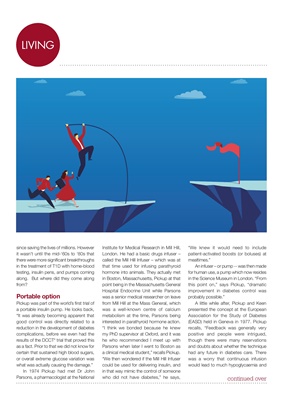
LIVINGLIVING
since saving the lives of millions. However
it wasn't until the mid-'60s to '80s that
there were more significant breakthroughs
in the treatment of T1D with home-blood
testing, insulin pens, and pumps coming
along. But where did they come along
from?
Portable option
Pickup was part of the world's first trial of
a portable insulin pump. He looks back,
"It was already becoming apparent that
good control was directly related to a
reduction in the development of diabetes
complications, before we even had the
results of the DCCT* trial that proved this
as a fact. Prior to that we did not know for
certain that sustained high blood sugars,
or overall extreme glucose variation was
what was actually causing the damage."
In 1974 Pickup had met Dr John
Parsons, a pharmacologist at the National continued over
Institute for Medical Research in Mill Hill,
London. He had a basic drugs infuser -
called the Mill Hill Infuser - which was at
that time used for infusing parathyroid
hormone into animals. They actually met
in Boston, Massachusetts, Pickup at that
point being in the Massachusetts General
Hospital Endocrine Unit while Parsons
was a senior medical researcher on leave
from Mill Hill at the Mass General, which
was a well-known centre of calcium
metabolism at the time, Parsons being
interested in parathyroid hormone action.
"I think we bonded because he knew
my PhD supervisor at Oxford, and it was
he who recommended I meet up with
Parsons when later I went to Boston as
a clinical medical student," recalls Pickup.
"We then wondered if the Mill Hill Infuser
could be used for delivering insulin, and
in that way mimic the control of someone
who did not have diabetes," he says,
"We knew it would need to include
patient-activated boosts (or boluses) at
mealtimes."
An infuser - or pump -- was then made
for human use, a pump which now resides
in the Science Museum in London. "From
this point on," says Pickup, "dramatic
improvement in diabetes control was
probably possible."
A little while after, Pickup and Keen
presented the concept at the European
Association for the Study of Diabetes
(EASD) held in Geneva in 1977. Pickup
recalls, "Feedback was generally very
positive and people were intrigued,
though there were many reservations
and doubts about whether the technique
had any future in diabetes care. There
was a worry that continuous infusion
would lead to much hypoglycaemia and